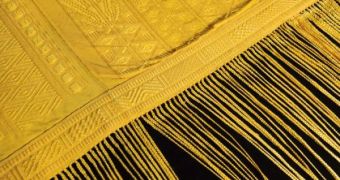The fact that spiders' webs are stronger than just about any material their size is widely known among scientists. Kevlar and steel strands as thin as spider threads have nothing on the natural compound, in terms of resistance and endurance. In an effort that went on for more than four years, a team of workers managed to create the world's largest spider silk cloth, complete with natural, golden color tones. The amazing object went on display at the American Museum of Natural History, in New York City, yesterday, Wired reports.
It took 70 workers more than four years to roam the streets and poles of Madagascar, and collect the sufficient number of spiders needed to complete this textile. Golden orb spiders were the only variety used in the effort, as they are the only species that can yield the golden silk. Once the spiders were trapped, a team of 12 workers got on the job of extracting about 80 feet of silk out of each and every one of them. All these fibers were later put together, and then woven into the golden cloth.
“Spider silk is very elastic, and it has a tensile strength that is incredibly strong compared to steel or Kevlar. There’s scientific research going on all over the world right now trying to replicate the tensile properties of spider silk and apply it to all sorts of areas in medicine and industry, but no one up until now has succeeded in replicating 100 percent of the properties of natural spider silk,” the co-leader of the new project, textile expert Simon Peers, says. The 11-foot-by-4-foot cloth is the only large-scale piece of textile material created completely out of natural spider silk.
The silk was extracted with the help of a machine that was originally devised by French missionary Jacob Paul Camboue. He created a hand-driven instrument that was able to extract silk from as many as 24 spiders at the same time, all without harming them. During the new initiative, a replica of the machine was built. “Simon managed to build a replica of this 24-spider-silking machine that was used at the turn of the century,” the other co-leader of the project, Nicholas Godley, explains.
Initially, only a small batch of 20 spiders was collected, and the team placed them inside the machine, to see how and if it worked. “When we stuck them in the machine and started turning it, lo and behold, this beautiful gold-colored silk started coming out,” Godley says. However, the two had a problem. “Fourteen thousand spiders yields about an ounce of silk, and the textile weighs about 2.6 pounds. The numbers are crazy,” Godley explains. More than one million female golden orb spiders were used during the manufacturing of the cloth.
Learning how to weave silk is a dream for scientists, in terms of the applications this could have. Naturally, spending four years to do this is not feasible. “When we talk about a spider spinning silk, we’re talking about how the spider applies forces to produce a physical transformation from liquid to solid. Scientists simply can’t replicate that as well as a spider does it. Every year we’re getting closer and closer to being able to mass-produce it, but we’re not there yet,” University of Akron spider-silk expert Todd Blackledge, who has not been part of the project, says.

 14 DAY TRIAL //
14 DAY TRIAL //